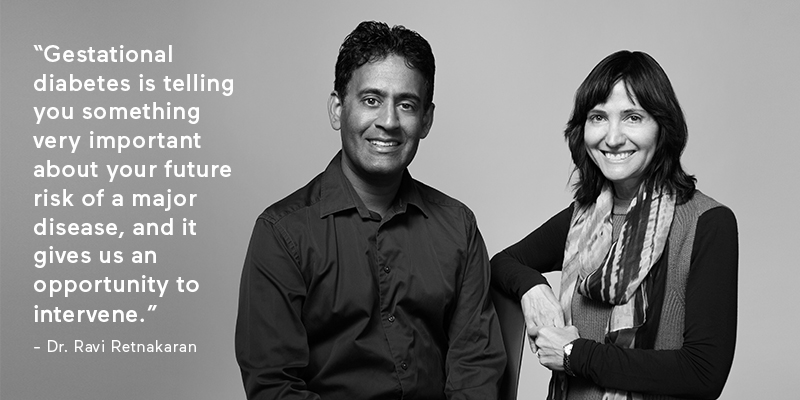
 Above: Victoria Cho
Above: Victoria Cho
Written By: Marcia Kaye
Photos By: John Packman
Victoria Cho had never heard of gestational diabetes until she was diagnosed with it during her pregnancy. She had certainly heard of diabetes — several members of her and her husband’s families had the disease. But learning that she had a form of diabetes herself came as a shock. “I was quite scared,” recalls Victoria, 33, diagnosed in 2015 when she was six months pregnant with her first child. “I felt it was something very serious that I might not be able to control.”
Victoria was right to be concerned. Gestational diabetes mellitus, or GDM, is a condition that needs to be taken seriously. If untreated, it can have significant effects on women and their babies. But GDM can be controlled. With careful management, most women diagnosed with GDM go on to have safe deliveries and healthy outcomes. Still, those women must be regularly monitored because of their higher lifetime risk of Type 2 diabetes and cardiovascular disease.
GDM is defined as glucose intolerance that has its first onset and recognition in pregnancy. It happens because a woman’s body can’t make or use enough insulin to respond to the increased demands of pregnancy, due to a chronic defect in her pancreatic beta cells. As a result she develops high blood sugar levels. That’s a problem, since blood sugar, or glucose, passes through to the growing baby. This prompts the baby’s pancreas to secrete extra insulin to move the glucose into the cells to use for energy. This may cause the baby to grow too large — often over nine pounds.
That can lead to complications such as premature birth, injuries from the delivery or the need for a Caesarean section. “There’s also a higher risk that the baby could have low blood sugar at birth and immature lungs,” says noted diabetes researcher and endocrinologist Dr. Denice Feig, Head of the Diabetes in Pregnancy Program at Mount Sinai Hospital, part of Sinai Health System, and an endocrinologist in Mount Sinai’s Leadership Sinai Centre for Diabetes, one of the leading centres for clinical research for diabetes in the world.
GDM is on the rise. Dr. Feig led a study showing GDM rates in Ontario women doubled between 1996 and 2010, with one in 10 pregnant women over 30 now affected. “It’s probably due to increasing obesity and a sedentary lifestyle,” she says, adding that the risk also increases with age. Other risk factors are family history of diabetes and ethnicity, including Asian, Black, Aboriginal, Hispanic and Latin American. But about half the women with GDM have no apparent risk factors at all.
GDM generally disappears completely after women give birth, but the biggest public misconception is that it can all now be forgotten. “Many people believe that gestational diabetes is just a disorder of pregnancy,” Dr. Feig says. “What they may not understand is it really identifies women who are at greater risk of developing Type 2 diabetes.” Dr. Feig’s team has done research showing that one in five women diagnosed with GDM will develop Type 2 diabetes within nine years, and two in five within 16 years. Among some non-Caucasian populations the rate rises even higher, to 50 percent. The children of GDM mothers also have a higher risk of developing Type 2 diabetes.
GDM raises the mother’s long-term risk of high blood pressure, high blood fats and metabolic syndrome. So whether or not she goes on to develop Type 2 diabetes, she will still have a higher-than-average risk of cardiovascular disease. That’s why it’s crucial for women who’ve had GDM to get checked within six months after their pregnancies and on a regular basis thereafter.
 Above: Dr. Ravi Retnakaran and Dr. Denice Feig
Above: Dr. Ravi Retnakaran and Dr. Denice Feig
Unfortunately, only 20 to 40 percent of women follow up, likely because most new moms are focused on their infants, not themselves. “This is one of the great missed opportunities in medicine,” says Dr. Ravi Retnakaran, who is an endocrinologist and Clinician-Scientist in the Leadership Sinai Centre for Diabetes and Associate Scientist at the Lunenfeld-Tanenbaum Research Institute, the research arm of Sinai Health System. He explains that a diagnosis of GDM offers a valuable preview of what may lie ahead. “It’s telling you something very important about your future risk of a major disease, and it gives us an opportunity to intervene before the development of that condition.”
Victoria was fortunate to be a patient at Mount Sinai. The Centre, by doing and offering research to women like Victoria, keeps up with the latest evidence and technology to improve the care and outcomes of women and their infants. It also works closely with the High Risk Pregnancy Clinic to deliver a multidisciplinary approach to the care of women with GDM. And it has knowledgeable diabetes educators who offer leading-edge classes and individualized counselling.
Victoria’s initial routine screening, which is recommended for all pregnant women between 24 and 28 weeks, involved drinking a sweet glucose drink in the doctor’s office, then having a blood test to measure blood sugar levels. They were high. A second test involved another glucose drink, this time after fasting, and further tests for blood sugar levels. Again, she “failed” the test, which confirmed she had GDM.
Victoria, just under 5’2” and with a pre-pregnancy weight of 125 pounds, wasn’t overweight. Nor was she sedentary — CrossFit workouts, and her job at a jewelry store in a busy Toronto mall kept her on her feet for hours. But with her Asian ancestry and family history of diabetes, she did have GDM risk factors.
“The doctors and nurses at Mount Sinai were all really, really good and calmed my fears. But they also reminded me to continue with what I’m doing or the diabetes could come back.”
- Victoria Cho
Like all women diagnosed with GDM at Mount Sinai, Victoria was encouraged to attend a free class run by a nurse and a dietitian, then go for individual counselling, all at the hospital. From these visits, she learned she needed to make some serious lifestyle changes. Instead of grabbing lunch in the food court or eating dinner when her shift ended at 9 or 10 p.m., she needed to eat three balanced meals and three snacks a day at regular times. She had to limit her favourite carbs — rice and noodles — to one cup per meal. Instead of a bowlful of sweet grapes, she could eat only five. She and her husband, Erle, began reading food labels and cooking more meals at home. Victoria started taking walks after meals to help her body use up glucose more quickly. She also learned to prick her finger to regularly test her blood sugar levels to ensure the changes were having an effect.
They did. Like 60 per cent of women with GDM, Victoria was able to control the condition just through dietary and lifestyle changes. (The other 40 per cent require injections of insulin, which does not cross the placenta or affect the baby.) In November 2015 she gave birth to a healthy seven-pound girl, Jaime Lillian, and since then she has dropped most of her pregnancy weight. “The doctors and nurses at Mount Sinai were all really, really good and calmed my fears,” says Victoria, whose follow-up testing three months after the birth showed no sign of diabetes. “But they also reminded me to continue with what I’m doing or the diabetes could come back.”
Dr. Retnakaran’s research team recently found that the sex of the baby can play a surprising role in GDM risk. The researchers found that mothers carrying male babies have a slightly higher risk of developing GDM because boys seem to have an adverse effect on the mothers’ glucose metabolism. Consequently, mothers who develop GDM while carrying a girl — in the absence of this adverse influence of a boy — are seven per cent more likely than GDM mothers of boys to develop Type 2 diabetes before their second pregnancy. Dr. Retnakaran’s team is currently designing interventional trials aimed at modifying the risk of developing Type 2 diabetes, using a variety of strategies including short-term insulin therapy.
Dr. Feig is now leading or co-leading two multi-centre, multinational trials. The first, CONCEPTT, is studying women with Type 1 diabetes to see if continuous glucose monitors can help improve outcomes for their pregnancies, which are typically high-risk. The second study, MiTy, is looking at whether adding the drug metformin to insulin for pregnant women with Type 2 diabetes will improve fetal outcomes and, over the long run, reduce obesity in the children.
Results from those studies aren’t in yet, but ongoing research into GDM will continue to improve the lives of women and their babies. “At Mount Sinai,” says Dr. Retnakaran, “women and infants are always a priority.”